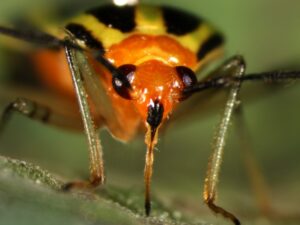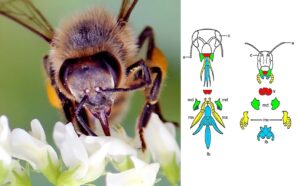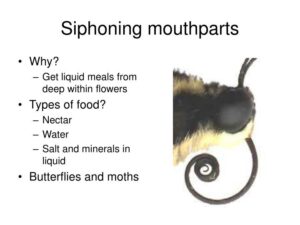Back to: Pre Vocational Studies JSS 1
Welcome to class!
In today’s class, we’re going to be talking about classification of insect pests based on mouth parts. I trust you will enjoy the class!
Introduction
Insect pests are insects that cause damage to crops, stored products, or other resources. Understanding the different types of mouthparts that insects possess can help us identify and control these pests more effectively.
Chewing Mouthparts

- Characteristics: Insects with chewing mouthparts have strong mandibles (jaws) and maxillae (pincers) that can bite, chew, and tear food. They are equipped with a labium (lower lip) and a labrum (upper lip) to manipulate food.
- Examples: Beetles, grasshoppers, caterpillars, and crickets.
- Damage: Chewing insects cause damage by eating leaves, stems, roots, or fruits. They can also bore into plants or stored products, creating tunnels and galleries. This type of damage can reduce plant growth, yield, and aesthetic value. In some cases, chewing insects can transmit plant diseases.
Sucking Mouthparts

- Characteristics: Insects with sucking mouthparts have a long, slender proboscis or beak that they use to pierce plants or animals and suck out fluids. The proboscis is often equipped with stylets, which are sharp, needle-like structures that penetrate the plant or animal tissue.
- Examples: Aphids, mealybugs, whiteflies, and mosquitoes.
- Damage: Sucking insects cause damage by draining sap from plants or sucking blood from animals. This can lead to stunted growth, wilting, yellowing, and even death. In addition, sucking insects can transmit plant viruses and other pathogens.
Piercing-Sucking Mouthparts
- Characteristics: Insects with piercing-sucking mouthparts have a long, sharp proboscis that they use to pierce plants or animals and suck out fluids. The proboscis is often equipped with stylets that can penetrate tough tissues.
- Examples: Bedbugs, lice, and tsetse flies.
- Damage: Piercing-sucking insects cause damage by draining sap from plants or sucking blood from animals. This can lead to stunted growth, wilting, and even death. In addition, these insects can transmit diseases, such as malaria and sleeping sickness.
Siphoning Mouthparts

- Characteristics: Insects with siphoning mouthparts have a long, coiled proboscis that they use to suck up liquids. The proboscis is often long and slender, allowing the insect to reach deep into flowers or other sources of nectar.
- Examples: Butterflies, moths, and flies.
- Damage: Siphoning insects can cause damage by feeding on nectar or other plant fluids. However, they are generally less damaging than chewing or sucking insects. In some cases, siphoning insects can be pollinators, which benefits plants.
Lapping Mouthparts
- Characteristics: Insects with lapping mouthparts have a short, fleshy proboscis that they use to lap up liquids. The proboscis is often covered in hairs or bristles that help to collect liquids.
- Examples: Flies, bees, and wasps.
- Damage: Lapping insects can cause damage by feeding on nectar or other plant fluids. They can also be a nuisance to humans, especially when they invade homes or gardens. In some cases, lapping insects can transmit diseases, such as dysentery.
Summary
Understanding the different types of insect mouthparts is essential for identifying and controlling insect pests. By knowing how insects feed, we can target their specific vulnerabilities and develop appropriate control measures. This information is valuable for farmers, gardeners, and pest control professionals.
We have come to the end of today’s class. I hope you enjoyed the class!
In the next class, we shall be discussing the effects of crop pests on yield.
In case you require further assistance or have any questions, feel free to ask in the comment section below, and trust us to respond as soon as possible. See you in the next class!
